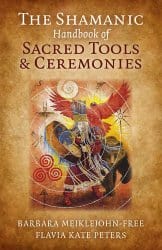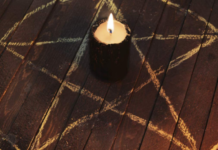
 The Shamanic Handbook of Sacred Tools and Ceremonies, by Barbara Meiklejohn-Free and Flavia Kate Peters
The Shamanic Handbook of Sacred Tools and Ceremonies, by Barbara Meiklejohn-Free and Flavia Kate Peters
Moon Books, 9781785350801, 153 pp., 2015
Potential is an unconscious criterion we use to select books. We read reviews or the jacket copy, we become intrigued, we buy it — and then when it doesn’t live up to our ideas of its potential, we become slightly disappointed. We’re not sorry we read it, and we learned something from it. It just didn’t hit that sweet spot of being a great read. Sadly, for me, The Shamanic Handbook of Sacred Tools and Ceremonies was like that, though the problem was not the material and its usefulness.
The book is written by two well-known British shamanic practitioners, Barbara Meiklejohn-Free and Flavia Kate Peters, who make it clear they live, love, and understand shamanism. However, a few things could have been differently so their thoughts were presented with more polish. (Coincidentally, I’m now evaluating a set of shamanic oracle cards by these authors for which the guidebook is clearly and elegantly written and edited, further proof that it’s not the authors’ knowledge of the material.)
The Shamanic Handbook is set up like a dictionary, with chapters presented alphabetically on such things as altars, the directions, elements, dreamtime, journeying, power animals and allies, rebirthing, and shapeshifting. There’s a short introduction that discusses what a shaman is (a good thing, because the chapter on shamans is fourth from the last) and the heart-wrenching and soul-opening challenges they will face on the path. The introduction says the book is for beginners, and for the most part it reads that way.
Yet in some areas the authors wrote as if the reader has had years of practice as a shamanic practitioner. For instance, in the chapter on healing, they write of how to prepare to receive clients and what to do during a healing. No! Healing others is not for beginners; someone who aspires to heal others must complete a good deal of inner work first, such as clearing emotional and mental blocks and patterns and forming a solid relationship with his or her own helping spirits. Once this is done, the practitioner becomes a “hollow bone,” or one who is able to receive healing energy and methods from Spirit, thus able to heal others. While the authors’ instructions are valid for trained practitioners, a warning could have been included, advising practitioners not to attempt this until much farther along in one’s studies.
In contrast to Evelyn C. Rysdyk‘s book on crafting one’s own shamanic tools, reviewed last year,1 gives step-by-step instruction on how to construct tools, this book gives a broad overview of what a tool is, the materials it may be made of, why it’s used and suggestions on how to use it, but no crafting instructions per se. For instance, The Shamanic Handbook gives a broader overview of drums, discussing their history and care, types of wood and skins, some ceremonial directions, and suggestions on where to buy one. A Spirit Walker’s Guide contains the actual instructions for making a drum and coming into relationship with it.
Meiklejohn-Free and Peters describe their personal experiences in detail throughout the book, quite fitting since shamanism is a path of direct experience. When you begin studying, your experiences can be so extraordinary that you might ask yourself if you’re making it up or if you’re going crazy. The reassuring tone of the authors’ voices is one of the strongest features of this book.
One of the weakest features is chapter size; it is incredibly inconsistent. Some chapters are 20 pages long, such as the aforementioned chapter on drumming, while others, such as the chapter titled “Cosmic Tree” (the three-world system), were two or three paragraphs long. Two or three paragraphs does not a chapter make, especially when the concepts are so central to shamanic worldview. For instance, the “Cosmic Tree” chapter and the somewhat longer “Journeying” chapter would have both be more effective had they been combined, since journeying takes place among the three worlds described in the “Cosmic Tree” chapter. It would have fostered a deeper understanding of both concepts, one which these teacher-authors would have well been able to give.
Like our sense of potential, well-organized and graceful writing is an unconscious criterion we use to judge books — and ultimately divide the mediocre from the outstanding. There’s much value in The Shamanic Handbook, yet it would have benefited from a critical eye and a skillful hand able to chisel it into a more elegant read.
- See Susan Starr’s review of A Spirit Walker’s Guide to Shamanic Tools: How to Make and Use Drums, Masks, Rattles, and Other Sacred Implements. [↩]







